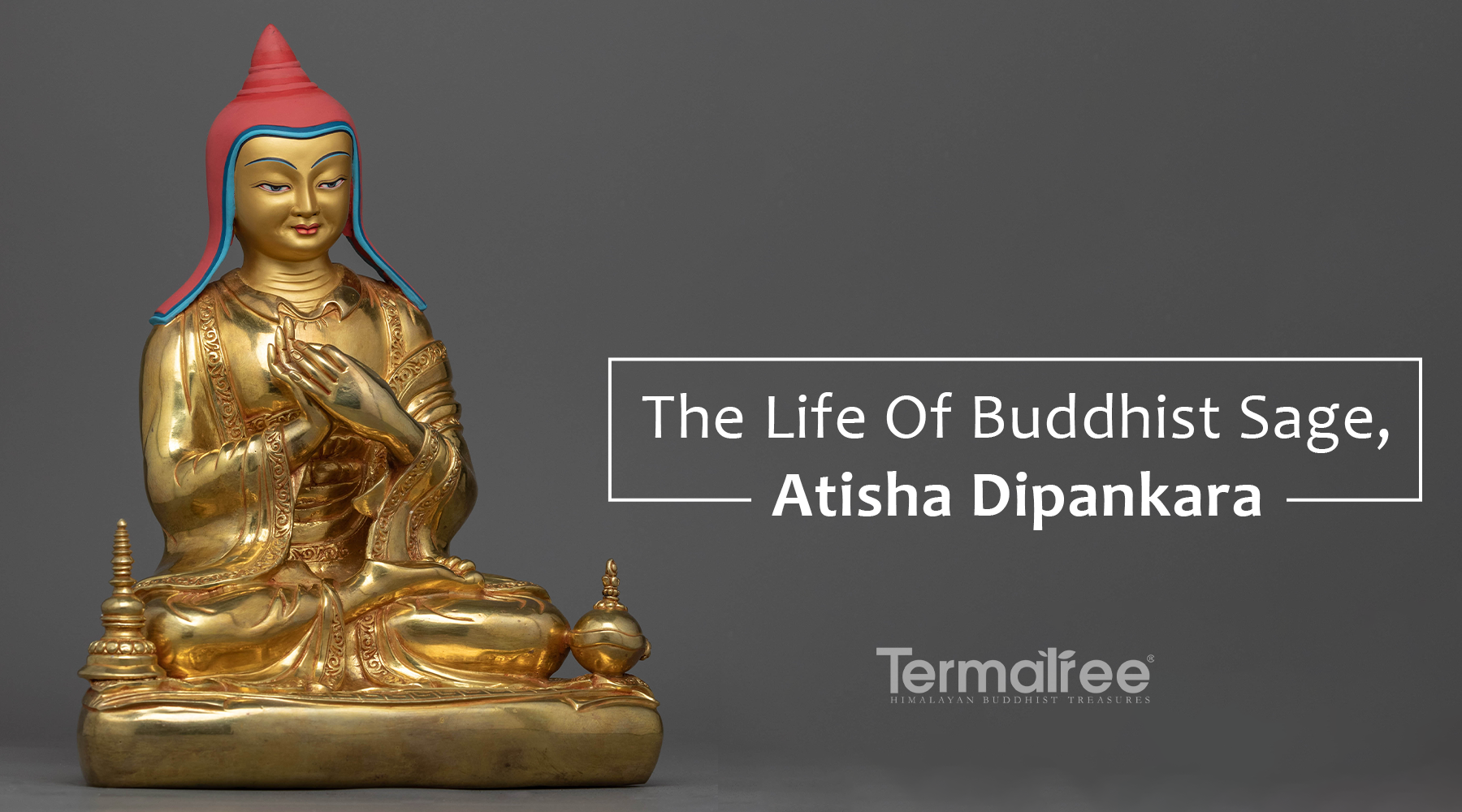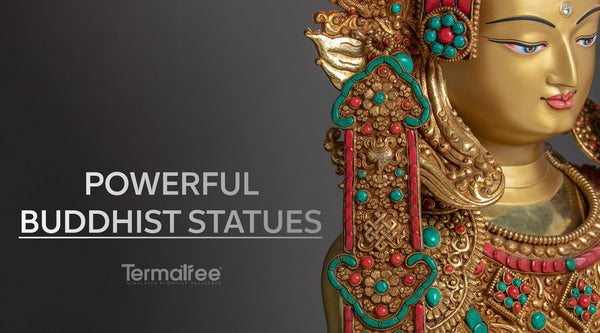The Life Of Buddhist Sage, Atisha Dipankara
Atisa Dipankara Shrijnana, a Buddhist teacher from the Pala Empire who, together with played a significant role in the creation of the Sarma lineages in Tibet following King Langdarma's suppression of Buddhism. He lived from 982 to 1052 C.E. (Glang Darma). He is believed to have been named Candragarbha at birth and to have been the second son of a royal family in eastern India. His mother was Prabhavati the Radiant, and his father was Kalyana the Good. Buddhists of all faiths continue to honor Atisha for his knowledge and compassion since he was key to bringing Tibetan teachings to India.
Iconography Of Atisha
Atisha is often depicted as a revered monk with a peaceful and kind expression. You can see in this statue the Buddhist monk wearing a traditional monastic robe of saffron or maroon color, with his right hand raised in a teaching gesture or holding a teaching staff and a yellow pandita hat, which symbolizes his status as a learned scholar. Atisha is also depicted holding a book or a scroll, representing his vast knowledge and wisdom.
Click here to view our Gold-Gilded Buddhist Master Statues
Sometimes there may be other symbolic elements, such as a dharma wheel, representing his teachings on the path to enlightenment, or a conch shell, describing his propagation of Buddhist philosophy. He may also be depicted with a nimbus of light or a halo, indicating his spiritual attainment and enlightenment. Overall, the iconography of Atisha in Tibetan thangka art reflects his importance as a revered teacher and spiritual leader in the history of Tibetan Buddhism and serves as a reminder of his teachings on compassion, wisdom, and the path to enlightenment.
Early Life
In the year 982 CE, Atisha was born in Bengal, India. He was admitted into the Buddhist monk order at the age of 12 and was known to be a remarkable learner from a young age. Atisha learned from some of the greatest Buddhist gurus of his era while still a young monk, and he later rose to prominence as a revered teacher in his own right.
Atisha, one of three royal brothers, was known as Chandragarbha for the most of his early years. He was given the Tibetan name Atisha, which means peace, when he went to Tibet and met the king Jangchub (Byang Chub Od).
From a tender age, Atisha revealed his potential as a prodigious religious and spiritual leader. The masses flocked from far and wide to witness his presence. Upon learning that these individuals were his subjects, Atisha implored the heavens to bestow upon them the same blessings and merits as his esteemed parents. He prayed that their kingdoms might prosper and their sons reborn as kings, upheld by virtue and holy deeds. He then proceeded to worship the divine objects inside and outside the temple, forsaking his ties to the worldly realm and his family, fully dedicating himself to his sacred calling.
Like the great Shakyamuni Buddha, the young prince evinced an innate aptitude for learning and practicing the Dharma from an early age. At the tender age of three, he had already acquired proficiency in the esoteric arts of astrology, writing, and Sanskrit. By ten years old, he could deftly distinguish between the teachings of Buddhism and those of other doctrines. Under the tutelage of more than a hundred learned instructors, the prince would become a master of Buddhism's Mahayana, Hinayana, and Vajrayana schools. Despite his growing enthusiasm to embrace a life of righteousness, the prince's parents, recognizing his brilliance and status as their natural successor, sought to secure his future by arranging a royal marriage at eleven amidst the splendor and excesses of his princely lifestyle.
Spiritual Training
Source: Enlightenment Thangka
On the eve of his wedding, Atisha chanced upon the Vajrayana goddess, Tara, who would continue to guide him throughout his life. Tara revealed to the prince that in his previous lives, he had been a devoted monk and urged him to eschew worldly pleasures. She warned him that without such renunciation, he would be mired in the quagmire of lust, akin to an elephant sinking deep into a bog. Tara's visitation signaled to Atisha his karmic potential, compelling him to abandon his kingdom, family, and status in search of a spiritual mentor, using a pretext of a hunting trip to deceive his parents.
The young man soon found himself under the tutelage of Jetari, a learned brahmin and renowned Buddhist hermit. Jetari imparted to Atisha the three fundamental tenets of Buddhism: taking refuge in the Three Jewels of Buddha, Dharma, and Sangha, and cultivating bodhicitta, a noble aspiration towards enlightenment for the benefit of all sentient beings. After learning the rudimentary principles of Mahayana Buddhism, Jetari advised Atisha to proceed to Nalanda, a prestigious center of Buddhist learning in northeastern India. There, Atisha received further instruction in the Bodhisattva vows under the tutelage of Bodhibhadra, who, in turn, urged him to seek out Vidyakokila, an esteemed master of meditation on emptiness.
Atisha's journey toward spiritual enlightenment was characterized by a profound dedication to studying and practicing Buddhist philosophy and meditation. His reputation as a spiritual adept stemmed from his unique ability to synthesize various Buddhist traditions and teachings into a unified and pragmatic system of spiritual practice.
Teachings and Legacy
Atisha emphasized cultivating compassion and wisdom as the bedrock of Buddhist practice. He devised the "Seven Points of Mind Training," a practical framework that offers guidelines for nurturing these qualities. The seven points involve developing gratitude and patience, turning obstacles into opportunities for growth, and cultivating lovingkindness and compassion towards all beings. These practices are designed to aid spiritual practitioners in overcoming negative emotions and attaining inner peace and wisdom.
In addition to his teachings on compassion and wisdom, Atisha stressed the importance of studying and practicing the teachings of the Buddha in a systematic and organized manner. He urged his pupils to engage in periods of intensive study and contemplation and to attain a deep comprehension of Buddhism's essential concepts and practices.
Atisha's teachings have had a lasting influence on Tibetan Buddhism, and he is widely regarded as one of its most significant figures. His teachings on compassion and wisdom have resonated with numerous generations of practitioners, and his legacy inspires those seeking spiritual enlightenment.
Moreover, Atisha's teachings have profoundly influenced the development of the Kadampa tradition of Tibetan Buddhism. This tradition advocates for integrating a spiritual practice into daily life, and it is known for its pragmatic and approachable approach to Buddhist philosophy and meditation.
Visit To Tibet
Late in the 10th century, Tibetan ruler Jangchub invited Atisha to visit Tibet. Atisha was initially apprehensive about traveling, but he ultimately consented after receiving a letter from Jangchub in which the king emphasized his real wish to receive instruction from him. After traveling to Tibet, Atisha spent more than ten years teaching and disseminating the Dharma. He is recognized for significantly advancing Tibetan Buddhism, particularly the Kadampa tradition. Even now, Tibetan Buddhism is still influenced by his teachings.
Atisha arrived in Tibet and settled in Ngari, where the King supported his efforts to spread the teachings of Buddha. During his three-year stay, Atisha wrote his main body of teachings, "A Lamp for the Path to Enlightenment," and met with his disciple, Tara Dromtonpa.
While in Tibet, Atisha discovered a vast collection of Sanskrit texts at the library of Samye's Pekar Kordzoling. He marveled at the widespread practice of Vajrayana in Tibet, surpassing even that of India. Atisha praised the previous dharma kings, translators, and panditas before him.
After spending thirteen years in Tibet, Atisha passed away in 1052 C.E. in a village near Lhasa called Lethan. His final resting place has become a shrine, and his ashes were brought to Dhaka, Bangladesh, and placed in the Dharmarajika Bauddha Vihara.





